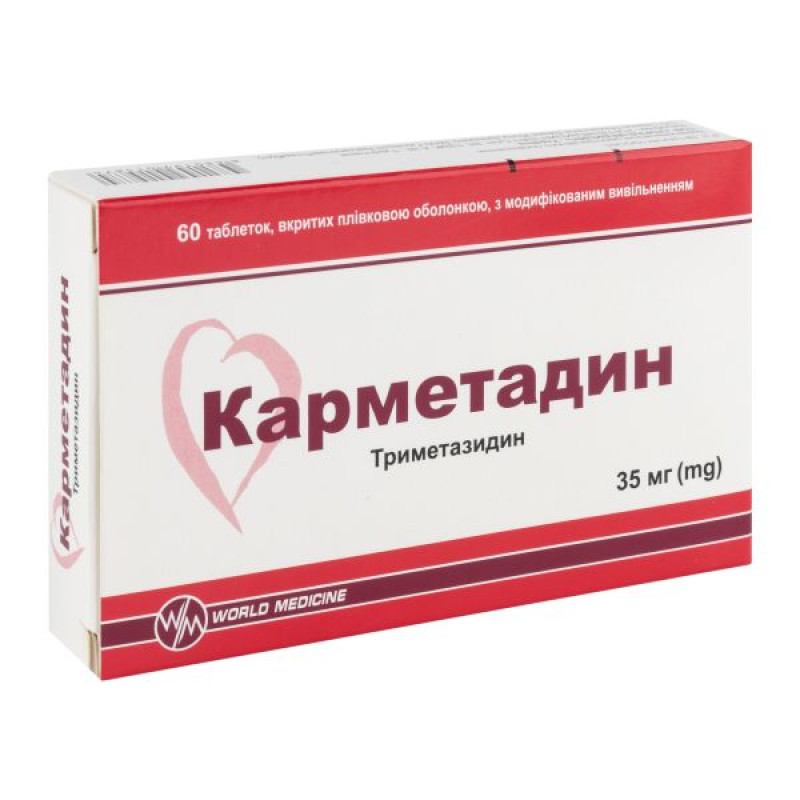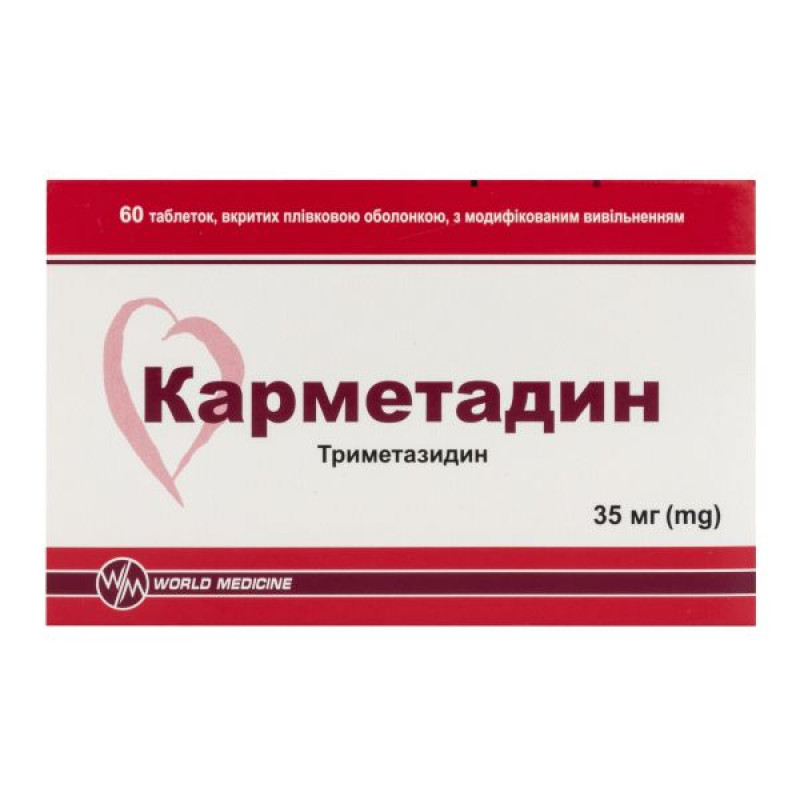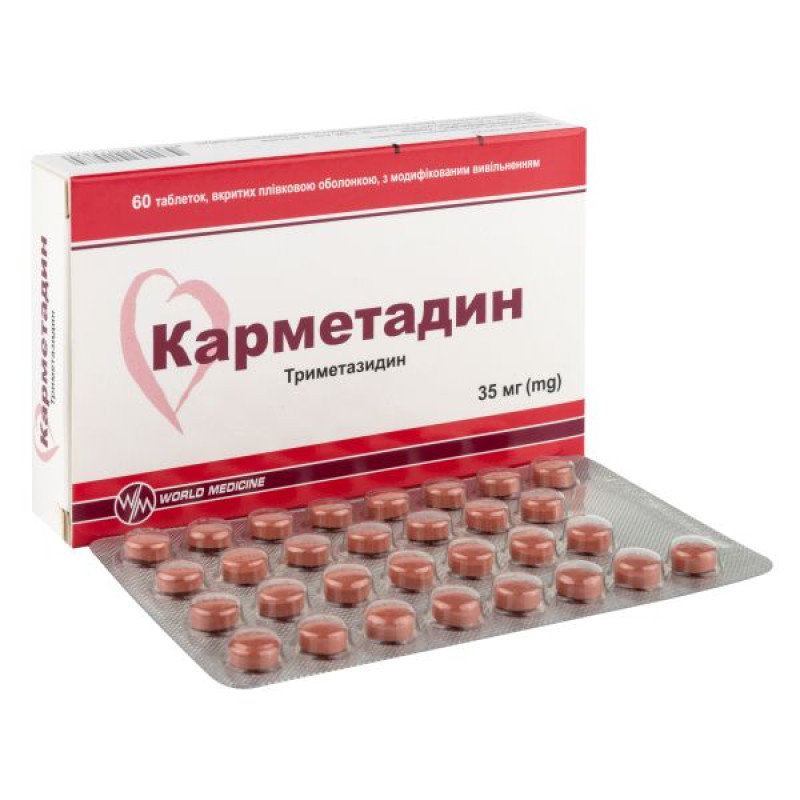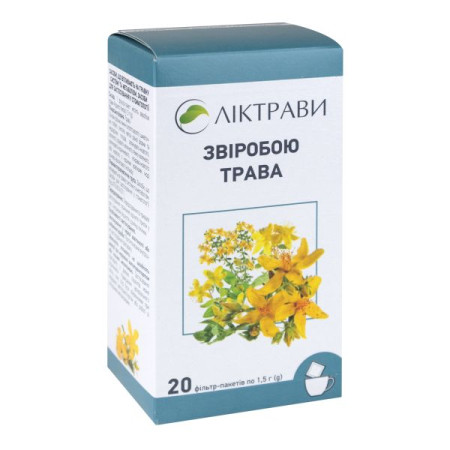Carmetadine film-coated tablets with modified release 35 mg No. 60

Instructions for Carmetadine film-coated tablets with modified release 35 mg No. 60
Composition
active ingredient: trimetazidine dihydrochloride;
1 tablet contains trimetazidine dihydrochloride 35 mg;
excipients: calcium hydrogen phosphate anhydrous, colloidal silicon dioxide anhydrous, polyethylene oxide, povidone, xanthan gum, magnesium stearate;
film coating: Opadry® II Brown 85G565010 (polyvinyl alcohol, talc, polyethylene glycol, titanium dioxide (E 171), lecithin (soy); red iron oxide (E 172)); magnesium stearate, glycerol.
Dosage form
Modified-release film-coated tablets.
Main physicochemical properties: round biconvex tablets, film-coated, pinkish-brown in color, engraved with "TZN" and "35" on one side.
Pharmacotherapeutic group
Cardiological drugs. Trimetazidine. ATC code C01E B15.
Pharmacological properties
Pharmacodynamics
Mechanism of action.
By preserving energy metabolism in cells suffering from hypoxia or ischemia, trimetazidine prevents a decrease in intracellular ATP levels, thereby ensuring the proper functioning of ion pumps and transmembrane sodium-potassium flux while maintaining cellular homeostasis.
Trimetazidine inhibits β-oxidation of fatty acids by blocking long-chain 3-ketoacyl-CoA thiolase (3-CAT), which increases glucose oxidation. In cells under ischemic conditions, the process of obtaining energy through glucose oxidation requires less oxygen compared to the process of obtaining energy through β-oxidation of fatty acids. The enhancement of the glucose oxidation process optimizes energy processes in cells and, accordingly, maintains sufficient energy metabolism under ischemic conditions.
Pharmacodynamic effects.
In patients with ischemic heart disease, trimetazidine acts as a metabolic agent, maintaining intracellular levels of high-energy phosphates in the myocardium. Anti-ischemic effects are achieved without concomitant hemodynamic effects.
Pharmacokinetics
Absorption.
After oral administration, the maximum concentration of trimetazidine in the blood plasma is observed on average after 5 hours. During the day, the concentration in the blood plasma remains stable: within 11 hours after taking the tablet, the concentration of trimetazidine in the blood plasma is equal to or higher than 75% of the maximum concentration. The steady-state concentration is reached at the latest by the 60th hour. Food intake does not affect the pharmacokinetic characteristics of trimetazidine.
Distribution.
The volume of distribution is 4.8 l/kg; protein binding is low: 16% according to in vitro measurements.
Breeding.
Trimetazidine is excreted mainly in the urine, mainly unchanged. The half-life is on average 7 hours in healthy young volunteers and 12 hours in people over 65 years of age. The complete elimination of trimetazidine is mainly the result of renal clearance, which is directly correlated with creatinine clearance, and to a lesser extent is the result of hepatic clearance, which decreases with age.
Special patient groups.
Elderly patients.
A special clinical study was conducted in elderly patients with trimetazidine 35 mg twice daily. The analysis performed using the population kinetic method showed an increase in plasma concentrations. In elderly patients, an increase in trimetazidine concentrations is possible due to age-related decline in renal function. A special pharmacokinetic study in patients aged 75–84 years or ≥ 85 years showed that in patients with moderate renal insufficiency (creatinine clearance 30–60 ml/min) the concentration of trimetazidine increased by 1.0 and 1.3 times, respectively, compared to younger patients (aged 30–65 years) with moderate renal insufficiency.
Patients with renal impairment.
The plasma concentration of trimetazidine increases on average by 1.7-fold in patients with moderate renal impairment (creatinine clearance 30–60 ml/min) and by 3.1-fold in patients with severe renal impairment (creatinine clearance < 30 ml/min) compared to healthy volunteers with normal renal function. No additional safety concerns were observed in this population compared to the general population.
Indication
Symptomatic treatment of stable angina in adults when first-line antianginal drugs are ineffective or intolerant.
Contraindication
Hypersensitivity to the active substance or to the excipients of the medicinal product.
Parkinson's disease, symptoms of parkinsonism, tremor, restless legs syndrome and other movement disorders related to the above.
Severe renal failure (creatinine clearance < 30 ml/min).
Interaction with other medicinal products and other types of interactions
No interactions of trimetazidine with other drugs have been reported.
Application features
In the event of an attack of unstable angina during current therapy, it is necessary to review the patient's disease status and adjust the treatment (drug therapy and the possibility of revascularization).
The use of the drug may cause or worsen parkinsonism symptoms (tremor, akinesia, muscle hypertonia), which should be regularly examined, especially in elderly patients. In doubtful cases, patients should be referred to a neurologist for appropriate examinations. If movement disorders such as parkinsonism symptoms, restless legs syndrome, tremor, gait instability occur, the drug should be discontinued. These cases have a low frequency and usually disappear after discontinuation of treatment, in most patients - within 4 months after discontinuation of trimetazidine. If parkinsonism symptoms persist for more than 4 months after discontinuation of treatment, a neurologist should be consulted.
During the use of the drug, falls associated with gait instability or arterial hypotension are possible, especially in patients taking antihypertensive treatment (see section "Adverse reactions").
The drug should be used with caution in patients at risk of increased concentrations: patients with moderate renal insufficiency (see sections "Pharmacokinetics" and "Method of administration and dosage") and patients over 75 years of age (see section "Method of administration and dosage").
Use during pregnancy or breastfeeding
Pregnancy.
There are no data on the use of trimetazidine in pregnant women. Animal studies do not indicate direct or indirect harmful effects with respect to reproductive toxicity. However, to avoid any risk, the drug is not recommended for use during pregnancy.
Breastfeeding period.
It is not known whether trimetazidine or its metabolites pass into breast milk. To avoid any risk to newborns/infants, the drug is not recommended for use during breastfeeding.
Fertility.
Reproductive toxicity studies showed no effect of trimetazidine on the fertility of female and male rats.
Ability to influence reaction speed when driving vehicles or other mechanisms
According to clinical studies, trimetazidine does not affect hemodynamics, however, in the post-marketing period, cases of dizziness and drowsiness have been reported (see section "Adverse reactions"), which may affect the ability to drive or use machines.
Method of administration and doses
The medicine is intended for oral use.
The recommended dose is 35 mg (1 tablet) 2 times a day, morning and evening, with meals.
After 3 months of treatment, the results of treatment should be evaluated and, if there is no effect, the use of the drug should be discontinued.
Special patient groups.
Patients with renal failure.
For patients with moderate renal impairment (creatinine clearance 30–60 ml/min), the recommended dose is 35 mg (1 tablet) per day in the morning with breakfast (see sections “Pharmacokinetics” and “Special warnings and precautions for use”).
Elderly patients.
In elderly patients, an increase in plasma trimetazidine concentrations is possible due to age-related decline in renal function (see section "Pharmacokinetics"). For patients with moderate renal insufficiency (creatinine clearance - 30-60 ml / min), the recommended dose is 35 mg (1 tablet) per day in the morning during breakfast. For elderly patients, the dose should be titrated with caution (see section "Special instructions").
Children
The safety and efficacy of trimetazidine in children (under 18 years of age) have not been established. Data are lacking.
Overdose
There is limited data on overdose with trimetazidine. In case of overdose, symptomatic treatment should be carried out.
Side effects
The following adverse reactions are listed by MedDRA system organ class and frequency: very common (≥1/10), common (≥1/100, <1/10), uncommon (≥1/1,000, <1/100), rare (≥1/10,000, <1/1,000), very rare (<1/10,000), not known (frequency cannot be estimated from the available data).
From the nervous system:
often - dizziness, headache; frequency unknown - parkinsonism symptoms (tremor, akinesia, muscle hypertonia), gait instability, restless legs syndrome and other movement disorders related to the above (usually disappear after discontinuation of treatment), sleep disorders (insomnia, drowsiness).
From the side of the organs of hearing and vestibular apparatus:
frequency unknown – vertigo.
From the heart:
rarely – palpitations, extrasystole, tachycardia.
From the vascular side:
rarely - arterial hypotension, orthostatic hypotension, which may be associated with malaise, dizziness or fall (especially in patients taking antihypertensive drugs), facial flushing.
From the digestive tract:
often - abdominal pain, diarrhea, dyspepsia, nausea and vomiting; frequency unknown - constipation.
From the hepatobiliary system:
frequency unknown – hepatitis.
often - rash, itching, urticaria; frequency unknown - acute generalized exanthematous pustulosis, angioedema.
From the blood and lymphatic system:
frequency unknown - agranulocytosis, thrombocytopenia, thrombocytopenic purpura.
On the part of the body as a whole:
often - asthenia.
Reporting of suspected adverse reactions.
Reporting suspected adverse reactions that occur after the registration of a medicinal product is very important. This allows for continuous monitoring of the benefit/risk balance of the medicinal product. Healthcare professionals should report any suspected adverse reactions through the national pharmacovigilance system.
Expiration date
3 years.
Storage conditions
Store at a temperature not exceeding 25 ºС in a place inaccessible to children.
Packaging
30 film-coated modified-release tablets in a blister; 2 blisters in a cardboard box.
Vacation category
According to the recipe.
Producer
WORLD MEDICINE ILAC SAN. VE TIC. AS, Turkey.
Location of the manufacturer and address of its place of business
15 Temmuz Mahallesi Cami Yolu Caddesi No:50 Gunesli Bagcilar/Istanbul/15 Temmuz Mahallesi Cami Yolu Caddesi No:50 Gunesli Bagcilar/Istanbul.
Applicant. WORLD MEDICINE ILAC SAN. VE TIC. AS, Turkey.
Address
15 Temmuz Mahallesi Cami Yolu Caddesi No:50 Gunesli Bagcilar/Istanbul/15 Temmuz Mahallesi Cami Yolu Caddesi No:50 Gunesli Bagcilar/Istanbul.
Applicant
WORLD MEDICINE ILAC SAN. VE TIC. AS, Turkey/ WORLD MEDICINE ILAC SAN. VE TIC. AS,
There are no reviews for this product.
There are no reviews for this product, be the first to leave your review.
No questions about this product, be the first and ask your question.


















